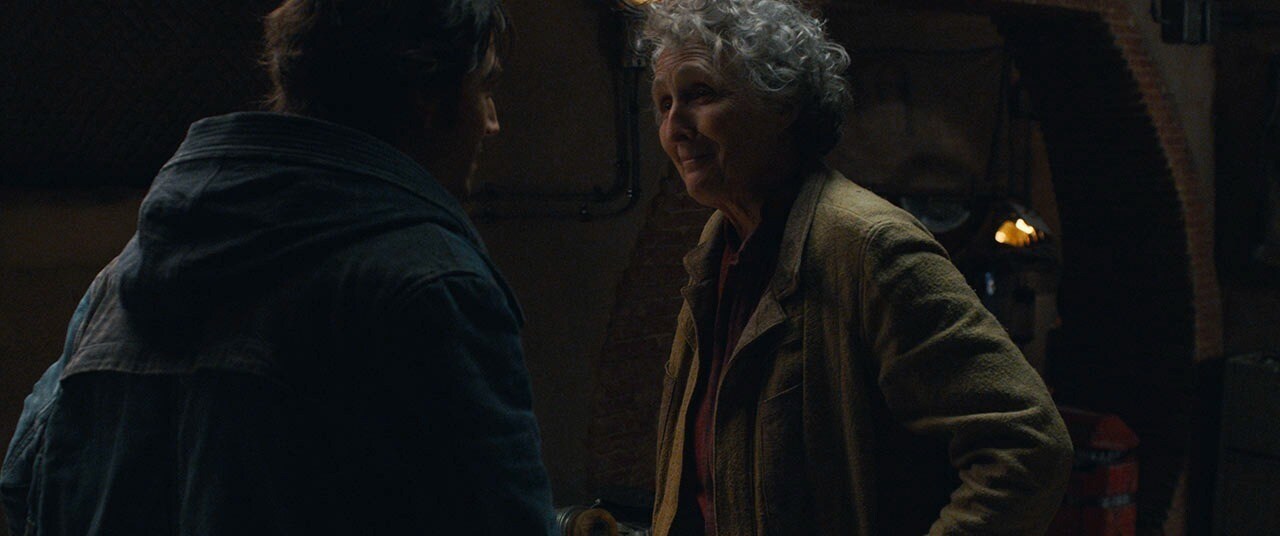From disposable prison uniforms to in-universe labels and logos, Wilkinson shares insights on some costuming details you may have missed.

Syril Karn’s pristine Pre-Mor uniform -- complete with “pockets, piping, and some light tailoring” -- is more than a hint at the character’s fussy nature and desire for the kind of order promised by the Empire. It’s also one of costume designer Michael Wilkinson’s favorite scenes in the series’ premiere episode, “Kassa.”
“I love that scene. Those two actors are so fantastic. And if I may say so, the costumes tell you quite a lot in that scene,” Wilkinson tells StarWars.com. “You have the precision and fastidiousness of Syril Karn's uniform that he has personalized, customized, and made exactly how he wants it to be. And then his boss, on the other hand, is wearing a uniform that’s crumpled and dirty and has a couple of stains down the front of his shirt and a jacket he shrugs on that he's had for 20 years.”
The two variations are among hundreds of costumes that Wilkinson and his team designed and fabricated for the actors on Andor, with all 12 episodes in Season 1 now streaming on Disney+. “I really enjoy playing with the language of clothes,” he says. “We wanted these things to be so rich with meaning and deserve repeated viewings that you could go deeper with it all. And, you know, it's the only way that I really know how to work, to actually construct these backstories and worlds and civilizations so that everything has meaning. Otherwise, it's fashion design, not costume design.”
Wilkinson recently sat down to talk about how his work helped telegraph Cassian Andor’s character evolution, the heartbreaking backstory on the costumes of Kenari, and the one item he kept from his time working on the production.


Finding Ferrix
In the planet-hopping story, now two planets are more crucial to Cassian’s development than Kenari and Ferrix.
Although the former is only glimpsed in flashbacks, Kassa’s time on Kenari form the foundation of the character we know as Cassian. After an industrial mining disaster, the children of the planet are left to fend for themselves, a tragedy Wilkinson expressed through found and foraged clothes. “It's your classic Lord of the Flies scenario,” Wilkinson says. “So they have this wild, primitive, feral kind of feel to it. And maybe that explains a little bit of older Cassian's innate wildness and rebellion.”
To echo the clan’s circumstances, Wilkinson envisioned the survivors crafting their own clothing language by utilizing the remnants and cast-off uniforms left behind by their parents as well as other natural elements. “We figured the kids would've used the uniforms of the adults to sort of chop up and repurpose. It had this primitive mix with work wear that they'd customized with feathers and beads and trinkets and stolen or foraged elements from the urban world that they used to live in, a mixture of modern industrial mixed with organic jungle textures.”

In contrast, Ferrix is a carefully curated community of industrial entrepreneurs, whose dedication to salvage is reflected in their rugged, utilitarian garb. Wilkinson wasn’t content to create a handful of silhouettes and dye them a variety of colors, making the people of Ferrix look more like they were wearing uniforms. Instead, he and his team infused individualism into every costume, reflecting the character it was worn by. At the outset, he encouraged his team to consider unique details to inform the design. “What is their job? Where do they get their clothes from? How does their clothing reflect what they do, who they are, and what's important to them.”
Japanese workwear inspired some of the silhouettes, the latest in a long history of legendary costume designers like Trisha Biggar on the prequels looking to our galaxy for inspiration. “Part of the success of Star Wars costuming is that there's always some connection with costumes that we know from our planet,” Wilkinson says. “There's always something that the audience can connect with and relate to. It gives you a shorthand, but then there's this wonderful abstraction and modernization of those influences. It's always coming from a place of authenticity and cultural resonance.”

The costume department went so far as to create different logos and unique symbols for in-world brands, repair shops, and individual businesses, deepening the lore and the tangibility of the planet with each specific detail. “We really went deep with those sorts of things,” Wilkinson says. “We chose the coolest and most interesting workwear elements between quilting, safety gear, and protective materials and things that created this world of Ferrixian clothing,” Wilkinson says. The wall of gloves, a collaboration between set designers and the costume shop, speaks to the ritualization of work in the Ferrix community, while some stand-out characters got more unique silhouettes to differentiate them from the crowd.

For example, Bix’s costumes speak to the character’s practicality and utilitarianism. “We created a great jacket that I'm really happy with an iconic neckline. It’s quite a cold planet so we incorporated elements like texture, a fleece lining, and a sort of Carhartt aesthetic,” Wilkinson says.







